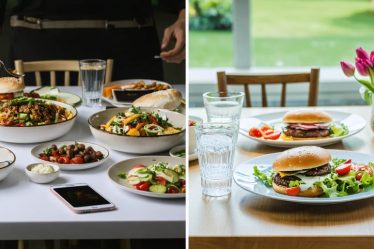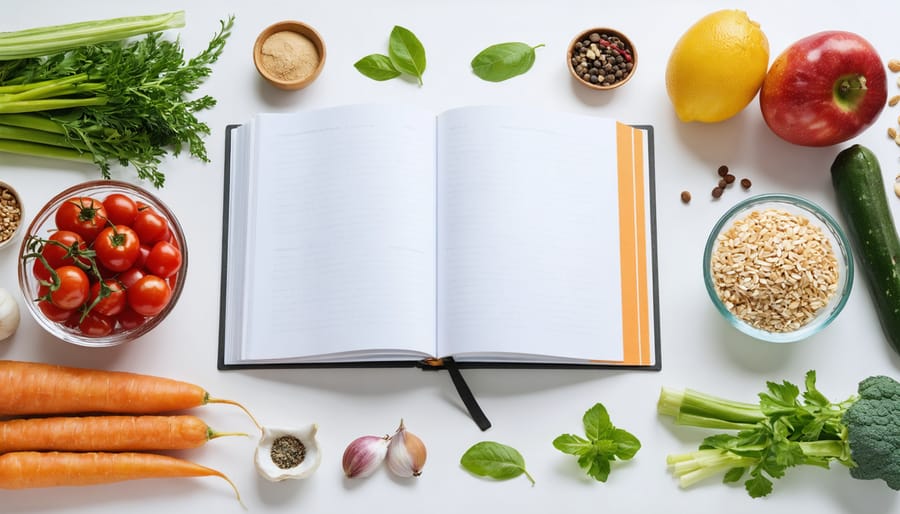
Stock your kitchen with wholesome ingredients like fresh produce, lean proteins, and whole grains. Having the right building blocks on hand makes it easier to prepare nutritious meals. Plan your meals in advance to avoid last-minute unhealthy choices. Take time each week to map out a menu, focusing on balanced dishes that incorporate a variety of nutrients. Adopt eco-friendly habits in the kitchen, such as using reusable containers, composting food scraps, and reducing waste. Small changes add up to a more sustainable and healthy lifestyle. Master simple cooking techniques like roasting, stir-frying, and grilling to prepare ingredients in tasty and nutritious ways without relying on excess fat, salt, or sugar.
Stock Your Kitchen with the Right Ingredients
Pantry Must-Haves
A well-stocked pantry is the foundation of healthy home cooking. Fill your shelves with versatile whole grains like quinoa, brown rice, and whole-wheat pasta for nutrient-packed meals. Don’t forget the legumes – lentils, chickpeas, and black beans are protein powerhouses that can bulk up salads, soups, and stews. Stock up on healthy oils like olive and avocado for cooking and dressing dishes. Lastly, add flavor with a variety of dried herbs and spices – think basil, oregano, cumin, and turmeric. With these staples on hand, you’ll be ready to whip up nourishing meals anytime.
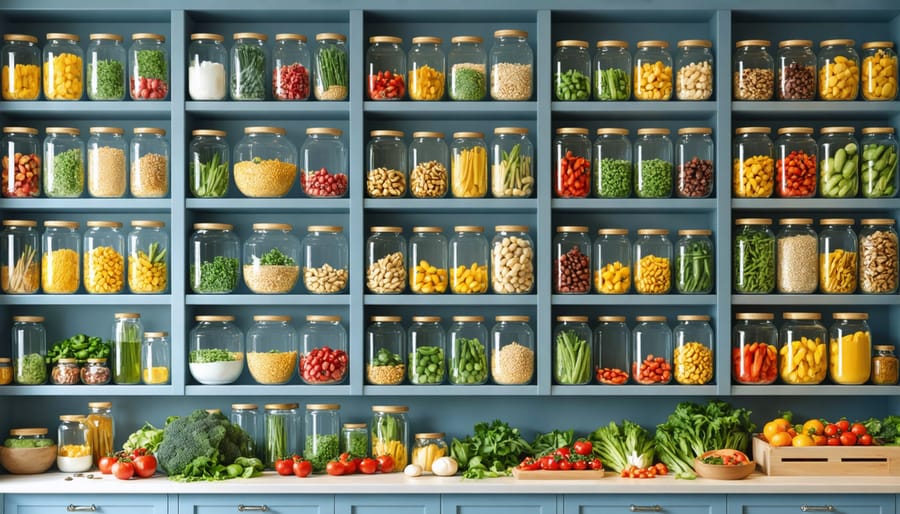
Fridge and Freezer Basics
To stock your fridge and freezer for healthy cooking, focus on fresh produce, lean proteins, and convenient frozen options. Load up on colorful fruits and veggies like leafy greens, bell peppers, berries, and citrus. Opt for lean meats such as chicken breasts, turkey, and fish. Low-fat dairy products like yogurt and cottage cheese are great for snacks and recipes. In the freezer, keep a variety of frozen fruits and vegetables on hand for quick meal additions. Frozen fish, shrimp, and precooked grilled chicken strips are lifesavers on busy nights. Don’t forget whole grain breads and tortillas for sandwiches and wraps. By keeping these nutritious staples readily available, you’ll be well-equipped to whip up healthy meals and snacks anytime hunger strikes. With a well-stocked fridge and freezer, you’re setting yourself up for success in your healthy cooking journey.
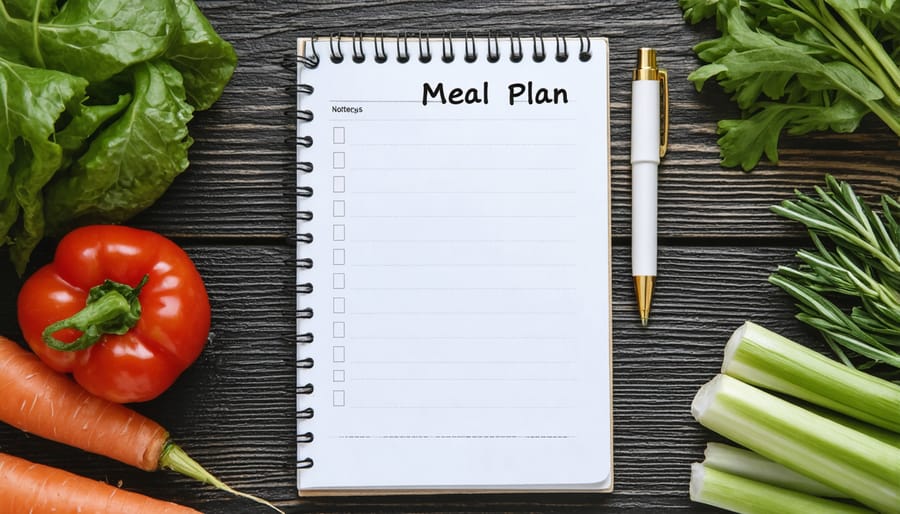
Plan Your Meals and Prep Ahead
Meal planning and prep can be a game-changer when it comes to cooking healthy food at home consistently. By taking some time each week to map out your meals and do a bit of advance preparation, you’ll set yourself up for success. Start by creating a weekly menu based on your schedule, dietary preferences, and any new recipes you’d like to try. Consider batch cooking staples like grains, proteins, and roasted veggies that can be mixed and matched throughout the week.
Once you have your plan, make a detailed grocery list to streamline your shopping trip. Aim to shop the perimeter of the store first, focusing on whole foods like produce, lean meats, and dairy. Don’t forget to read labels carefully and stock up on healthy pantry essentials that make weeknight cooking a breeze.
When you get home from the store, take a few minutes to wash and chop produce, portion out snacks, and cook any ingredients that will form the foundation of your meals. You might hard-boil eggs for easy breakfasts, bake a batch of chicken breasts, or simmer a pot of quinoa. By frontloading this prep work, you’ll have nutritious building blocks ready to transform into satisfying meals all week long, even when life gets hectic. Remember, a little planning goes a long way in helping you reach your healthy eating goals!
Master Quick and Healthy Cooking Methods
Learning quick and healthy cooking methods is key to making nutritious meals at home on a busy schedule. Stir-frying is a great option – heat a small amount of oil in a wok or large skillet, then cook proteins and veggies over high heat while stirring constantly. The food cooks fast and retains its color, crunch, and nutrients.
Roasting is another simple technique. Toss ingredients like diced potatoes, chicken pieces, or vegetable medleys with olive oil, herbs, and spices. Spread in a single layer on a baking sheet and roast in a hot oven until tender and caramelized. Minimal prep and hands-off cooking make this an easy choice.
For the gentlest cooking, try steaming. Fill a pot with an inch of water and bring to a boil. Place fish fillets, chicken breasts, or vegetable pieces in a steamer basket above the water. Cover and steam until cooked through. Steaming preserves the most nutrients, texture, and natural flavors.
Other speedy options include broiling proteins or kabobs, pressure cooking beans and tough cuts of meat, and pan-searing foods like scallops or skinless poultry. With a handful of basic techniques, you can create endless healthy meals to fit your tastes and timelines. Don’t be afraid to experiment, adapt recipes, and find your kitchen groove. Your body will thank you!
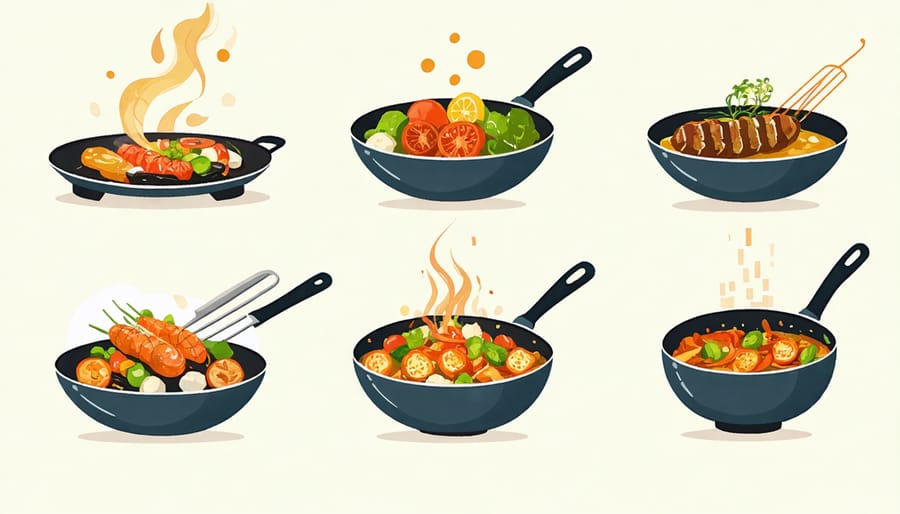
Get Creative with Flavor Boosters
Elevating the flavor of your healthy home-cooked meals doesn’t have to mean compromising on nutrition. One of the easiest ways to add excitement to your dishes is by experimenting with herbs and spices. Fresh herbs like basil, cilantro, and thyme can brighten up any recipe, while dried spices such as cumin, paprika, and turmeric offer bold, complex flavors. Don’t be afraid to get creative with your spice blends – try a dash of cinnamon in your chili or a sprinkle of smoked paprika on roasted vegetables.
Citrus fruits are another fantastic way to add zing to your cooking. A squeeze of lemon or lime juice can transform a simple salad dressing or marinade, while zested orange peel can add a sweet, aromatic note to baked goods or sauces. For a tangy kick, experiment with different vinegars like balsamic, apple cider, or rice wine vinegar. These acidic ingredients help balance flavors and can make a dish pop.
Other flavor boosters to keep on hand include garlic, ginger, and onions. These aromatic staples form the base of many delicious recipes and can be used in countless ways. Roasting garlic mellows its pungent flavor and creates a creamy, spreadable texture perfect for adding depth to dips or spreads. Grating fresh ginger into stir-fries, soups, or smoothies adds a spicy, invigorating bite. By getting creative with these simple, healthy ingredients, you’ll never have to settle for bland, uninspired meals again.
Sneak in Extra Nutrients
One simple way to sneak extra nutrients into your meals is by blending veggies into sauces. Puree cooked carrots, bell peppers, or squash and stir them into pasta sauce, curry, or soup. The added veggies bring a boost of vitamins and fiber while seamlessly integrating into the dish’s flavor profile. Another tasty trick is to add fruit to salads. Toss sliced strawberries, mandarin oranges, or diced apples with your favorite greens for a refreshing twist that packs an antioxidant punch.
When baking, experiment with swapping out some of the butter or oil with mashed banana, applesauce, or pureed pumpkin. These nutritious alternatives add natural sweetness and moisture to muffins, quick breads, and even brownies. Sprinkle a handful of seeds like chia, flax, or hemp into yogurt, oatmeal, or smoothies for a discreet dose of healthy fats and minerals.
Embracing variety and thinking outside the box are key to boosting the nutrient density of your homemade meals. Challenge yourself to include a new vegetable or fruit each week, and don’t be afraid to get creative with your cooking methods and flavor combinations. Before you know it, sneaking in those extra nutrients will become second nature, and your body will thank you for fueling it with wholesome, delicious ingredients.
Make Healthy Swaps and Substitutions
Making healthy swaps and substitutions in your recipes is a simple way to boost the nutritional value of your meals without sacrificing flavor. For example, try using Greek yogurt instead of sour cream in dips, sauces, and baked goods for a protein-packed alternative. Swap out white flour for nutrient-dense options like almond flour, coconut flour, or whole wheat pastry flour in your favorite recipes. When it comes to cooking oils, choose heart-healthy options like olive oil, avocado oil, or coconut oil instead of vegetable oils. In dishes that call for heavy cream, experiment with using pureed cauliflower or cashews for a creamy, plant-based twist. Amp up the fiber in your meals by replacing white rice with quinoa, brown rice, or cauliflower rice. Remember, small healthy swaps can make a big difference in the overall nutritional profile of your dishes. Don’t be afraid to get creative and experiment with new ingredients to discover delicious and wholesome combinations that your family will love.
Conclusion
Incorporating healthy home cooking into your lifestyle is not only achievable but also incredibly rewarding. By stocking your kitchen with nutritious ingredients, mastering basic cooking techniques, and experimenting with recipes, you’ll be well on your way to enjoying delicious, wholesome meals that nourish your body and soul. Remember, small changes can make a big impact, so start with simple tweaks and build on your skills over time. As you gain confidence in the kitchen, you’ll find yourself excited about healthy eating and eager to explore new flavors and ingredients. Embrace the journey, have fun, and savor the delicious results of your efforts. Your taste buds and your well-being will thank you!


